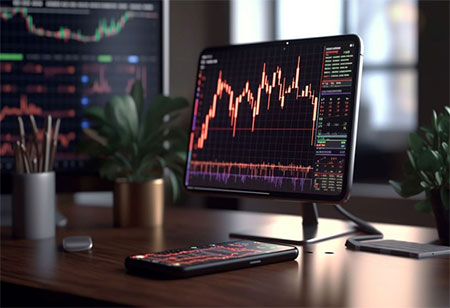
Just like Columbus navigating the seas, you're about to embark on your own exploration – the world of trading platforms. They might seem daunting, but don't worry! We've got you covered.
This guide will demystify the types, features, and selection process of trading platforms. You'll soon be navigating trades with confidence.
Buckle up, it's time to dive into the basics of trading platforms and steer your investment journey in the right direction.
Understanding Trading Platforms
As a new trader, it's crucial for you to understand what a trading platform is and how it operates. A trading platform is essentially a software interface provided by brokerage firms to their customers to carry out trades and manage their accounts. It's where you'll be doing all your buying, selling, and market research.
You're probably wondering how trading platforms work. Well, they connect you, the trader, to the market. They fetch real-time quotes, charts, and news feeds, providing you with the information you need to make informed decisions.
If you're new to trading, you might be interested in a MetaTrader 5 tutorial for beginners, which can help you navigate this platform effectively. Accuracy in this data is paramount. A delay of even a few seconds in the display of this information can cost you significant sums. That's why it's essential to choose a platform with a proven track record of providing accurate, up-to-the-minute data.
Accuracy in this data is paramount. A delay of even a few seconds in the display of this information can cost you significant sums. That's why it's essential to choose a platform with a proven track record of providing accurate, up-to-the-minute data.
Not all platforms are created equal though. Some offer advanced charting tools, others excel in ease of use. It's your job to find the one that best suits your trading style and goals. So, research, compare, and test before you commit.
This foundation of understanding is vital for your trading journey.
Types of Trading Platforms
Now that you've grasped the basics of trading platforms, let's delve into the various types they come in. These platforms differ primarily based on the type of asset they focus on and their access to markets. They're designed to cater to different trading styles and investor needs.
Here are the main types of trading platforms:
It's essential that you choose the platform that fits your trading style and needs. Your decision should be driven by your trading goals, the markets you want to access, and the tools you need.
Features of Effective Platforms
Once you've identified the type of trading platform that suits your needs, it's time to dive into the five key features you should look for to ensure your chosen platform is effective and reliable.
Firstly, the platform's usability is paramount. You'll need a platform that's intuitively designed, allowing you to navigate quickly and easily.
Secondly, it should offer a comprehensive set of trading tools. These will help you analyze market trends, research stocks, and make informed trades.
Thirdly, the platform must offer real-time data. This is crucial as even a slight delay in information can drastically impact your trading decisions.
Fourthly, customer support should be readily available. In the event of technical hitches, you'll need fast, reliable assistance.
Lastly, look for a platform that provides a secure trading environment. Your personal and financial data must be safeguarded against cyber threats. Platforms should use data encryption and two-factor authentication to ensure maximum security.
Choosing Your Trading Platform
After considering all the essential features, it's time for you to decide on the trading platform that's perfect for your needs. Choosing the right platform can significantly influence your trading experience and financial outcomes.
To make a data-driven decision, you need to consider:
Remember, what works for one trader mightn't work for you. Analyze your trading habits, style, and needs. Are you a day trader or a long-term investor? Do you prefer desktop or mobile trading? Do you need educational resources?
Navigating Your First Trade
With your chosen trading platform's features at your fingertips, it's time to dive into your first trade. It might seem daunting, but with precision and a keen eye for detail, you'll navigate it smoothly.
Firstly, understand the asset you're trading. Whether it's stocks, commodities, or currencies, each has specific market trends and factors influencing their prices. Research these thoroughly. Analyze historical data, study market indicators, and stay updated with financial news.
Next, decide on your 'Order Type'. Market orders are immediate, executed at the best available price. Limit orders allow you to set a specific price at which you're willing to buy or sell.
Then, determine the number of units you wish to trade. This depends on your capital, risk tolerance, and trading strategy. Always remember to set a 'Stop Loss' to limit potential losses, and a 'Take Profit' to secure gains when the price hits your target.
Lastly, review your order. Double-check all parameters before clicking 'Submit'.
Conclusion
So, you're on the brink of your first trade, armed with knowledge and ready to dive into the world of trading platforms. Remember, the choice of your platform can make or break your trading journey. It's about more than just the interface—it's about the features, the data, the analytics. Choose wisely, navigate carefully, and above all, stay data-driven.
The next step? It's all in your hands. The suspense is real, isn't it?